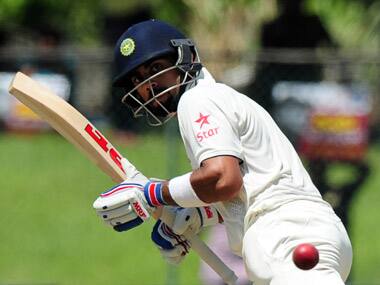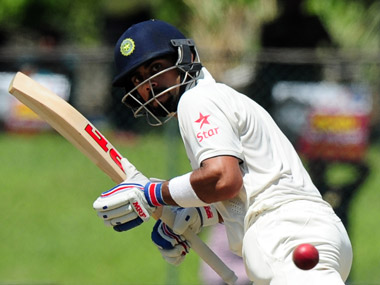Sri Lanka and India shared honours on the first day of the second Test at the P Sara Oval. The match ebbed and flowed with Sri Lanka stealing initiative early, before India fought back. However, Sri Lanka took three wickets in the final session to keep India from running away with the advantage. KL Rahul was the star with the bat for India, making the most of a reprieve on 11 to reach his second Test hundred. He was ably assisted by his captain Virat Kohli, who looked odds on to make yet another hundred before Angelo Mathews produced a stunning piece of slip-catching to cut Kohli’s innings short. India sprung a couple of surprises though, with Ajinkya Rahane walking out to bat at No. 3 and Rohit Sharma at No. 5 Here are three things we took from the first day’s play: Does Virat Kohli know his own mind? Before the series began, Kohli was categorical about Rohit batting at No. 3. Rohit had been moved around too much and needed a settled spot in the batting order. Coming in at one-down would also give Rohit the opportunity to change a match given his ability to score quickly. [caption id=“attachment_2401036” align=“alignleft” width=“380”]
 Virat Kohli. AFP[/caption] Yet one Test later, Rahane walks out after Murali Vijay was trapped LBW in the first over. Is this tacit admission that Rohit doesn’t have the technique to bat at No. 3? Or is this a one-off because a wicket fell early and India did not want to expose Rohit to the new ball? Either way, it is a decision which doesn’t project confidence in Rohit’s ability to handle the responsibilities that come with batting at one-down. Any batsman who occupies that position has to be able to handle the new ball because openers are going to get out early. If India feel the need to protect Rohit, he isn’t the right person to come in after the first wicket falls. The double negative is it destabilises Rahane as well. Now two players don’t have settled spots in the line-up. That seems like a shaky foundation for success, especially since Rahane has made runs in the middle-order. Rahane also has a tendency to play away from his body early in his innings, which led to his downfall in the fifth over of the day. This isn’t a good trait against a moving ball. Finally, the decision raises questions about Kohli’s thinking process. So far, Kohli has been both positive and clear about his intentions. To suddenly move away from his stated intention after just one Test is both surprising and unlike him. It suggests a certain amount of confusion in India’s thinking and if the captain is confused or uncertain about how his team should play, the risk is the uncertainty flows through to the team as well. . To be fair, captains sometimes have to make decisions on the fly and adjust to conditions. But it’s hard to imagine a Ricky Ponting, Brian Lara, Sir Donald Bradman or Rahul Dravid not walking out with the score at 4/1 in the very first over. Rohit’s half-century raises more question than it answers Rohit made 79 batting at No. 5, falling in the last over of the day to a ball that seamed into him and trapped him LBW. While Rohit looked good for a hundred, following his failures at No. 3 in the first Test, this innings should ease the pressure on him. However, that it came in the middle order confuses things further. The truth is, there is a big difference between opening in one-day cricket and batting in the top three in Test cricket because the red ball moves a lot more than the white ball. On flat pitches it would matter less but where the ball does a little, as it did at the P Sara, Rohit appears to have neither the temperament nor the technique to cope with it. Talent is only one part of the equation. Temperament is the other and while Rohit wins the talent battle, Rahane and Cheteshwar Pujara have the edge when it comes to temperament. Rohit is more likely to succeed batting in the middle order than the top. How Kohli juggles the trio of Rohit, Rahane and Pujara is likely to have significant impact on the success of this team over the next few years. If he gets it wrong, four careers could suffer, including his own as captain. KL Rahul rescues India Rahul needs to send the cricketing Gods a thank you card. Injuries are currently his only route to getting a game for India, but if he keeps making hundreds, that could change. He had one moment of luck. A thick edge flew to gully, where Jehan Mubarak dropped a relatively simple catch, seemingly surprised by how quickly the ball got to him. That stay of execution appeared to jolt any complacency out of Rahul’s system and together with Kohli, he dragged India out of danger and into a position of relative security. Another wicket at that stage, and Rohit would have walked out with the ball still relatively new, and another Indian batting collapse would not have been out of the question. In that respect, Rahul’s confident 108 from 190 balls was invaluable. Just like in Australia, where Rahul learned from the poor shot he played in his debut Test to make a century in his next Test, Rahul appeared to have learned from his mistakes in Galle. His footwork was more assured against the new ball and he was willing to leave deliveries that he did not have to play at. He was similarly decisive against the spinners, coming down the track at first to get to the pitch of the ball, before deciding the sweep was the better weapon. What he still needs to learn is not to throw away his wicket after getting to a hundred. Both in Sydney and at the P Sara Oval, Rahul played similar poor shots to get out – trying to pull deliveries that bounced more than he expected. If he wants to knock Vijay or Shikhar Dhawan off their perch, he needs ‘daddy hundreds’ to press his case.
Virat Kohli. AFP[/caption] Yet one Test later, Rahane walks out after Murali Vijay was trapped LBW in the first over. Is this tacit admission that Rohit doesn’t have the technique to bat at No. 3? Or is this a one-off because a wicket fell early and India did not want to expose Rohit to the new ball? Either way, it is a decision which doesn’t project confidence in Rohit’s ability to handle the responsibilities that come with batting at one-down. Any batsman who occupies that position has to be able to handle the new ball because openers are going to get out early. If India feel the need to protect Rohit, he isn’t the right person to come in after the first wicket falls. The double negative is it destabilises Rahane as well. Now two players don’t have settled spots in the line-up. That seems like a shaky foundation for success, especially since Rahane has made runs in the middle-order. Rahane also has a tendency to play away from his body early in his innings, which led to his downfall in the fifth over of the day. This isn’t a good trait against a moving ball. Finally, the decision raises questions about Kohli’s thinking process. So far, Kohli has been both positive and clear about his intentions. To suddenly move away from his stated intention after just one Test is both surprising and unlike him. It suggests a certain amount of confusion in India’s thinking and if the captain is confused or uncertain about how his team should play, the risk is the uncertainty flows through to the team as well. . To be fair, captains sometimes have to make decisions on the fly and adjust to conditions. But it’s hard to imagine a Ricky Ponting, Brian Lara, Sir Donald Bradman or Rahul Dravid not walking out with the score at 4/1 in the very first over. Rohit’s half-century raises more question than it answers Rohit made 79 batting at No. 5, falling in the last over of the day to a ball that seamed into him and trapped him LBW. While Rohit looked good for a hundred, following his failures at No. 3 in the first Test, this innings should ease the pressure on him. However, that it came in the middle order confuses things further. The truth is, there is a big difference between opening in one-day cricket and batting in the top three in Test cricket because the red ball moves a lot more than the white ball. On flat pitches it would matter less but where the ball does a little, as it did at the P Sara, Rohit appears to have neither the temperament nor the technique to cope with it. Talent is only one part of the equation. Temperament is the other and while Rohit wins the talent battle, Rahane and Cheteshwar Pujara have the edge when it comes to temperament. Rohit is more likely to succeed batting in the middle order than the top. How Kohli juggles the trio of Rohit, Rahane and Pujara is likely to have significant impact on the success of this team over the next few years. If he gets it wrong, four careers could suffer, including his own as captain. KL Rahul rescues India Rahul needs to send the cricketing Gods a thank you card. Injuries are currently his only route to getting a game for India, but if he keeps making hundreds, that could change. He had one moment of luck. A thick edge flew to gully, where Jehan Mubarak dropped a relatively simple catch, seemingly surprised by how quickly the ball got to him. That stay of execution appeared to jolt any complacency out of Rahul’s system and together with Kohli, he dragged India out of danger and into a position of relative security. Another wicket at that stage, and Rohit would have walked out with the ball still relatively new, and another Indian batting collapse would not have been out of the question. In that respect, Rahul’s confident 108 from 190 balls was invaluable. Just like in Australia, where Rahul learned from the poor shot he played in his debut Test to make a century in his next Test, Rahul appeared to have learned from his mistakes in Galle. His footwork was more assured against the new ball and he was willing to leave deliveries that he did not have to play at. He was similarly decisive against the spinners, coming down the track at first to get to the pitch of the ball, before deciding the sweep was the better weapon. What he still needs to learn is not to throw away his wicket after getting to a hundred. Both in Sydney and at the P Sara Oval, Rahul played similar poor shots to get out – trying to pull deliveries that bounced more than he expected. If he wants to knock Vijay or Shikhar Dhawan off their perch, he needs ‘daddy hundreds’ to press his case.
Tariq Engineer is a sports tragic who willingly forgoes sleep for the pleasure of watching live events around the globe on television. His dream is to attend all four tennis Grand Slams and all four golf Grand Slams in the same year, though he is prepared to settle for Wimbledon and the Masters.
)